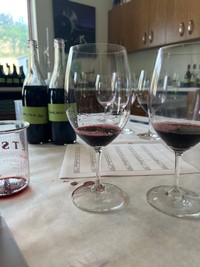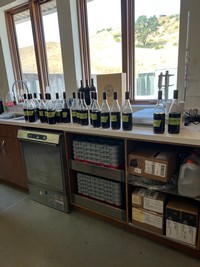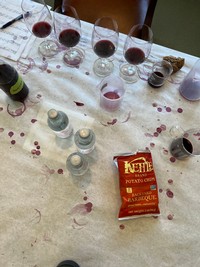Blending the future
What does it take to craft a Somerston wine? Somerston wines showcase the highest quality single-block wines on the property. You may ask yourself, "What does that mean?" or "How do they ensure that?" The first round of blending recently took place, and while it may be confusing to refer to blending single-varietal wines, blending is more than blending different varietals to make a red wine. Here, we explore what it takes and what our team of artists, also known as winemakers, do to create these beautiful pieces of art that will soon be painted across a canvas or your empty glass that our bottles of wine will eventually fill.
Due to the nature of the incredibly unique composition of our property, our winemaking team is tasked with navigating upwards of 1,000 of variations from 200+ blocks, rootstocks, varietals, soils, elevations, to microclimates while crafting our wines. And that doesn’t even cover our extensive barrel program after the fermentation process. Since we believe wine is made in the vineyard, our winemakers evaluate every lot with the intention of qualifying only the highest level of quality wines to bear the Somerston Estate label for your optimal enjoyment.
 To start this day of blending, Director of Viticulture & Winemaking Craig Becker enters the room and exchanges warm greetings with fellow teammates before heading into the marathon of sipping, sampling, evaluating, and, eventually, blending. The group finally takes their seats around the table situated in the middle of the lab that usually serves as a catchall for various production supplies on a typical day, but for today—it serves as a blank canvas (literally covered end to end with white paper) for these artists to start using to craft the high-end wines of Somerston Estate and Priest Ranch.
To start this day of blending, Director of Viticulture & Winemaking Craig Becker enters the room and exchanges warm greetings with fellow teammates before heading into the marathon of sipping, sampling, evaluating, and, eventually, blending. The group finally takes their seats around the table situated in the middle of the lab that usually serves as a catchall for various production supplies on a typical day, but for today—it serves as a blank canvas (literally covered end to end with white paper) for these artists to start using to craft the high-end wines of Somerston Estate and Priest Ranch.
Once everyone settles in, they look at the countertop spanning the perimeter of the room, filled wall to edge with bottles of barrel samples that will need to be tasted individually and blended together by the end of the day. Each seat starts with one wine glass, a spittoon, and a stack of papers with what, to the naked eye, looks like hieroglyphics strewn across them but are clear and understood by the assembly seated at the table. Eventually, each person’s collection of glasses grows from one to four to accommodate a day’s-worth of samples and various blends until decisions are made. And like that, we’re off.
Priest Ranch Winemaker Cody Hurd begins pouring for the group, which kicks off the sniffing, swirling, more sniffing, and finally, a sip. Ears begin to buzz with the sounds of mini aerations happening as the masterminds analyze the samples. This is followed by spits, more sips, and then someone breaks the silence. After the first sips, the conversations that weave between observations of the samples and lighthearted, playful jokes break the ice ahead of the miles of wines the group will be tasting through. Slowly but surely, a small dent in the lineup is made.

While exchanging personal stories is easy to understand, the language of winemaking is foreign to those outside of the wine world. When they talk about vineyards, varietals, differing percentages or levels, if you’re not in on what they’re talking about or you briefly zone out, you will find yourself completely lost. The things discussed are almost in code. It’s part mutual respect, part long-term relationship. A baseline knowledge shared by the team sitting at the table allows them to use as few words as possible and still understand exactly what each other means. There are few to no times within the blending session that someone questions one of the others about what they mean, what they’re referring to, or anything of the sort. It’s truly like being in a foreign country and watching and listening to locals speak.
Finally, as the group nears the completion of this blending session, there can be as few as three and as many as six per vintage(s). After 500 sips, teeth and lips are stained from the juvenile wines the group has powered through. Phones are opened, dates for the next session are exchanged, then finalized, and then chairs are pushed back, and the masters of their craft disperse and go back to their daily tasks. There are moments like this that bring such a lightness to a process that is so heavily weighted for a luxury portfolio of wines like Somerston and Priest Ranch that almost give you whiplash but at the same time is a representation of beauty and skill that these craftsmen possess.
The table is now filled with stained glasses, white paper sprinkled with drops of wine samples, notes scribbled to keep track of the wines tried; the stack of papers breaking down each sample has since been placed in notebooks or backpacks or added to files on desks for a later time. A peacefulness falls across the table as the subtle clinking of glasses acts as white noise after all departs after a clean-up of the remnants of a hard day’s work.
This phase of winemaking is incredibly important and sacred to winemakers of all kinds. Aside from premium vineyards and a meticulous vineyard management team, it sets a portfolio of luxury Napa Valley wine apart from our colleagues. So, the next time you find yourself enjoying a Somerston wine, raise your glass to the talented group of people from the vineyard to the lab and cellar, who crafted the wine as a pure labor of love for all to savor.
From all of your friends at Somerston Estate, cheers!



